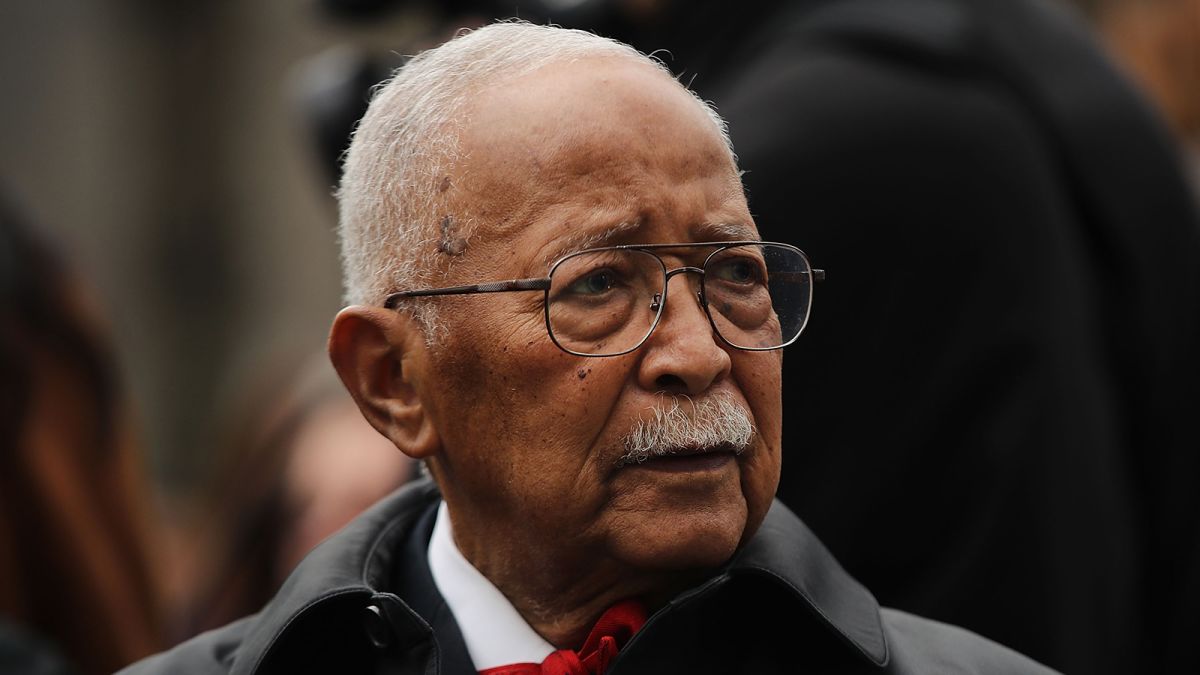By: Monee’ Fields-White, The Root
New York, NY — David Dinkins, who became the first Black mayor of the nation’s largest city, died Monday night at his Upper East Side home in Manhattan at age 93, according to the New York Times. His death occurred a little more than a month after his wife, Joyce, who died in October.
Many of New York’s top luminaries from both sides of the political aisle hailed Dinkins as a devoted public servant and trailblazer who paved the way for other Black politicians.
“David was a historic mayor. He showed that a Black candidate can win biracial support in a citywide race,” said former New York Gov. David Paterson, who was the first African-American governor, according to the New York Post.
“I extend my deepest condolences to the family of Mayor David Dinkins, and to the many New Yorkers who loved and supported him,” Former NYC Mayor Rudy Giuliani, who lost to Dinkins in 1989, wrote on Twitter, the Post noted.“He gave a great deal of his life in service to our great City. That service is respected and honored by all.”
“David Dinkins was a forerunner to Barack Obama. He was elected saying the same things,” Rev. Al Sharpton told the Post. “He helped to change the psychology of American politics, making it more inclusive and more progressive.”
Born on July 10, 1927, David Norman Dinkins grew up with his mother and grandmother in Trenton, N.J.; his parents divorced when he was 7. After graduating in the top 10 percent of his high school class, he went on to Howard University, where he was known as “Dink.” His studies were briefly interrupted when he enlisted to serve in World War II. He tried to join the Marine Corps but was initially told that the “Negro quota” had been met. He went into the Army instead but would eventually serve in the Marines as well.
Dinkins returned to Howard and graduated magna cum laude with a degree in mathematics. He also met his wife, Joyce Burrows, at the school. Her father was Daniel Burrows, a former assemblyman and district leader who pushed his son-in-law to consider a career in politics.
In 1953 Dinkins enrolled at Brooklyn Law School. After graduating, he began his political trek by becoming involved in Harlem’s Carver Club. Formed by the self-proclaimed “Harlem Fox” J. Raymond Jones, the organization groomed young Black business and political leaders and was key to the city’s overall structure. Other notables among Dinkins’ peers included Basil Paterson, Charlie Rangel and Percy Sutton.
Dinkins won his first elective office in 1965 as a representative in the New York State Assembly. After two years, his district was redrawn and he chose to hold off running again. Mayor Abraham Beame offered him a post as deputy mayor, which Dinkins accepted but had to turn down after news reports that he hadn’t paid taxes surfaced. He resolved the issue by paying up, and the party appointed him city clerk—a position that consisted primarily of signing marriage certificates.
He won his bid for Manhattan borough president in 1985 after three tries. Four years later he was elected the city’s 106th mayor, defeating incumbent Mayor Ed Koch in the Democratic primary and the Republican candidate, former prosecutor Rudolph Giuliani, in the general election.
Dinkins’ campaign had emphasized his ability to bring together the many races in a city marred by racial tensions, and he famously called New York a “gorgeous mosaic.” Dinkins’ talents as a consensus builder and racial healer would be tested by events such as the Black community’s 1990 boycott of Korean grocery stores in Brooklyn and the 1991 Crown Heights riots, which began after a car in a motorcade of prominent Jewish rabbis in Brooklyn killed a young Black child.
Dinkins’ administration also quickly came under fire for its handling of the economy and crime. Dinkins had inherited a $1.8 billion deficit, and the 1990 recession led to the loss of 300,000 private sector jobs, which sapped the city’s tax base. He tried to balance the budget by cutting city jobs and services as well as raising taxes. He was also hurt by criticism that crime in the city was out of control, although crime rates for almost all categories declined during the latter part of his four-year term, and he bulked up the New York City Police Department by almost 25 percent.
In seeking re-election, the erudite, elegant Dinkins would once again face the brash, no-nonsense Giuliani. But this time, Dinkins’ low-key management style was depicted as weak leadership. His reputation as a racial healer had also taken a beating, and his support among key groups like whites, Jews and Asian Americans had dropped considerably. In 1993 Dinkins lost to Giuliani, getting only 46 percent of the vote. No Democrat was elected mayor of New York again until Bill de Blasio in 2013.
After leaving office, Dinkins became a professor of public affairs at Columbia University and remained politically active. He endorsed numerous city mayoral candidates, including Democrats Mark Green in 2001 and Fernando Ferrer in 2005. In 2008 he was a New York delegate for Hillary Clinton in her presidential campaign.
He also offered his insights Saturday mornings on Dialogue With Dinkins, a radio program on Black-themed AM station WLIB. Dinkins was a member of both Alpha Phi Alpha—the oldest Greek-letter African-American fraternity—and Sigma Pi Phi, the oldest Black professional fraternity.
Photo Caption:
Former New York City Mayor David Dinkins attends a ceremony at the National September 11 Memorial for those killed in the February 26, 1993 truck bomb attack at the World Trade Center on February 26, 2018 in New York City. Photo: Spencer Platt (Getty Images)






